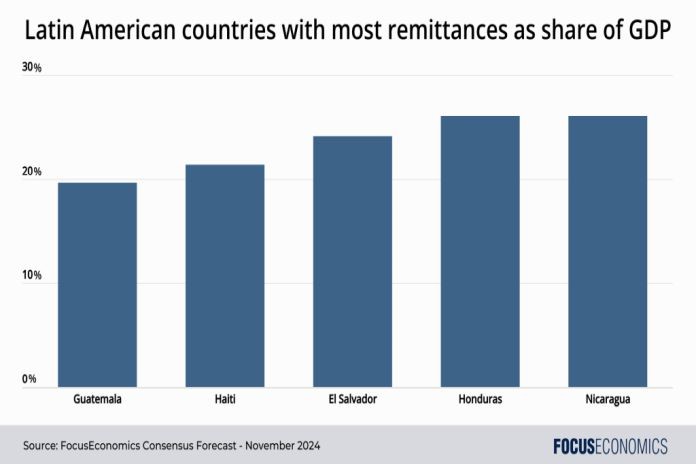Caribbean News Global (CNG) November 13, 2024
Washington (CNG):
Mexico’s economy is intertwined with that of its northern neighbor: The US is the destination of around 80 percent of Mexico’s exports and provides it with more than half of all imports. Finally, Latin America enjoys a large goods trade surplus with the US a particular bugbear of Trump’s which could put the region in his crosshairs once elected.
Remittances to suffer: Remittances are a critical income source for the region – particularly in Central American countries, where they are often worth over 20 percent of GDP. The vast majority of these remittances stem from migrants working in the US With policy towards both legal and illegal immigrants set to tighten under Trump, remittance flows to the region are likely to take a hit, weighing on the incomes of Latin American households. If, as is possible, albeit less likely Trump follows through with his threats of mass deportations, this could strain social systems in the Latin American countries that end up housing the deportees; on the flipside, deportations could boost government and private spending in recipient countries.
Commodity shake-up: Trump has promised to “drill, baby, drill”. US hydrocarbon production which is already at a record high is likely to increase further under his term as he loosens restrictions on oil and gas. This could reduce US demand for imported oil, affecting exporters like Brazil, Ecuador, Mexico and Venezuela. At the same time, Trump is likely to cut government support for clean energy technology, taming demand for metals that play an important role in the green transition cobalt, copper, lithium and zinc to name but a few. Latin America has many of these metals in abundance; potentially lower demand and prices for these metals under Trump bodes poorly for the region’s exports and fiscal revenue.
US-China relations: If Trump jacks up tariffs on Chinese imports as he’s threatened to do, this could have multiple effects on Latin America. It could lead to greater re-export trade via Latin America particularly through Mexico in order to circumvent tariffs. It could also encourage more firms to invest in manufacturing facilities on the continent as opposed to in China. But US tariffs on China could also weaken the Asian giant’s economy, and therefore its appetite for Latin American raw materials, hitting the region’s exports.
The bottom line: Whichever way one looks at it, Trump’s second term spells turbulent times for a region which is already suffering from the ills of political polarization, social instability, crime, corruption and gaping inequality.





